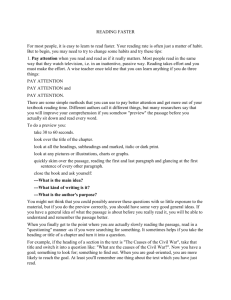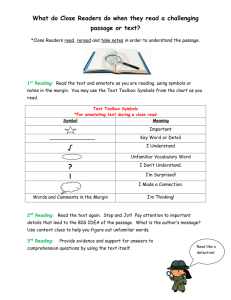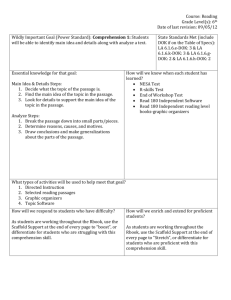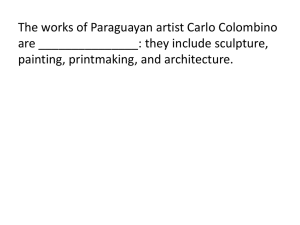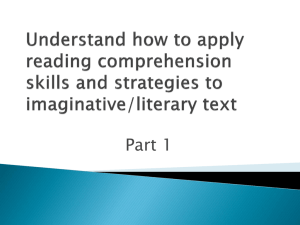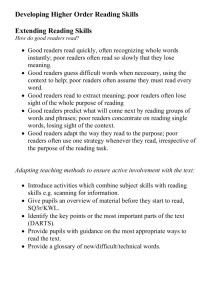Beers` keynote - Clarington Central Secondary School
advertisement
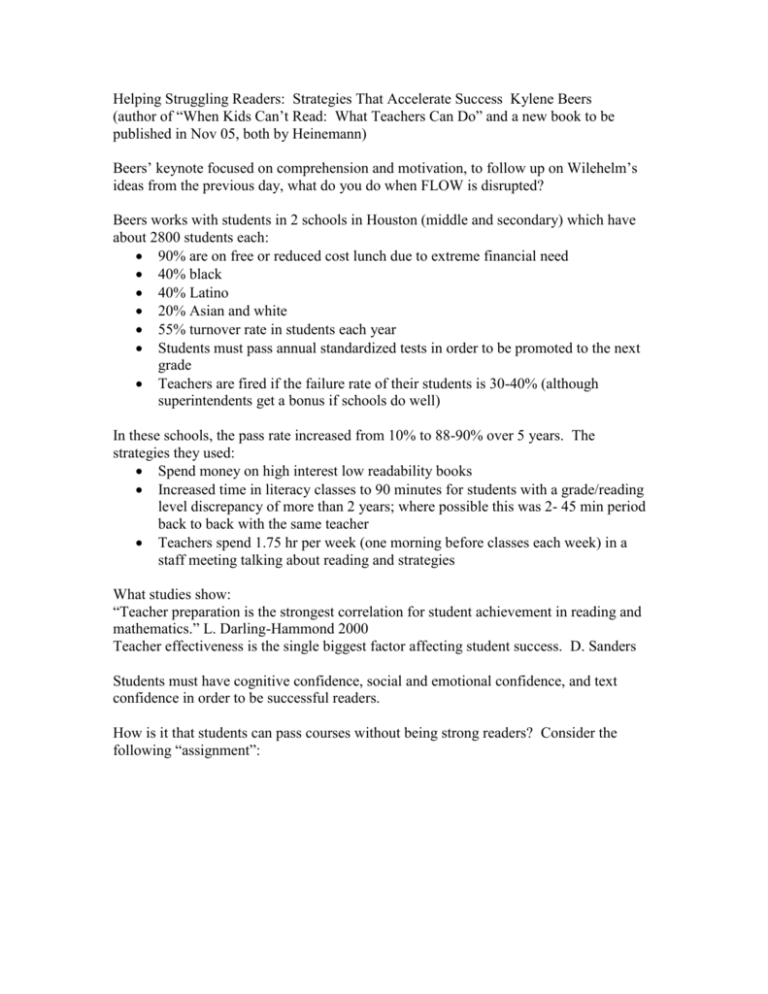
Helping Struggling Readers: Strategies That Accelerate Success Kylene Beers (author of “When Kids Can’t Read: What Teachers Can Do” and a new book to be published in Nov 05, both by Heinemann) Beers’ keynote focused on comprehension and motivation, to follow up on Wilehelm’s ideas from the previous day, what do you do when FLOW is disrupted? Beers works with students in 2 schools in Houston (middle and secondary) which have about 2800 students each: 90% are on free or reduced cost lunch due to extreme financial need 40% black 40% Latino 20% Asian and white 55% turnover rate in students each year Students must pass annual standardized tests in order to be promoted to the next grade Teachers are fired if the failure rate of their students is 30-40% (although superintendents get a bonus if schools do well) In these schools, the pass rate increased from 10% to 88-90% over 5 years. The strategies they used: Spend money on high interest low readability books Increased time in literacy classes to 90 minutes for students with a grade/reading level discrepancy of more than 2 years; where possible this was 2- 45 min period back to back with the same teacher Teachers spend 1.75 hr per week (one morning before classes each week) in a staff meeting talking about reading and strategies What studies show: “Teacher preparation is the strongest correlation for student achievement in reading and mathematics.” L. Darling-Hammond 2000 Teacher effectiveness is the single biggest factor affecting student success. D. Sanders Students must have cognitive confidence, social and emotional confidence, and text confidence in order to be successful readers. How is it that students can pass courses without being strong readers? Consider the following “assignment”: Corandic is an emurient grof with many fribs; it granks from corite, an olg which cargs like lange. Corite grinkles several other tarances, which garkers excarp by glarcking the corite and starping it in tranker-clarped storbs. The tarances starp a chark which is expaged with worters, branking a slorp. This slorp is garped through several other corusces, finally frasting a pragety, blickant crankle: coranda. Coranda is a cargurt, grinkling corandic and borigen. The corandic is nacerated from the borigen by means of loracity. Thus garkers finally ghrap a glick, bracht, glupous grapant, corandic, which granks in many starps. 1. 2. 3. 4. 5. What is corandic? What does corandic grank from? How do garpers excarp the tarances from the corite? What is coranda? Would you like some corandic in your home? All it takes to get 80% is perseverance. You don’t need to understand what you’re reading. If you can match the words in the questions to the words in the passage, you get an A. What percentage of the questions you ask in class are “corandic” questions? Our struggling readers need our most engaging questions to keep them from zoning out. Now try this one – read the following and decide what 3 words are the keys to understanding the entire paragraph. (This demonstrates the need to be able to use content cues, syntax and connections to phonics to decode a passage.) When can you just skip a word and when is it important to making meaning in a text? (I’ll put the answer at the very end of this document.) The Blonke The blonke was maily, like all the others. Unlike the other blonkes, however, it had spiss crinet completely covering its fairney cloots and concealing, just below one of them, a small wam. This particular blonke was quite drumly – lennow, in fact, and almost samded. When yerden, it did not quetch like the other blonkes, or even blore. The others blored very readily. It was probably his bely timber that had made the one blonke so drumly. The bellytimber was quite kexy, had a strong shawk, and was apparently venenated. There was only one thing to do with the venenated bellytimber: grivel it in the flosh. This would be much better than to sparple it in the wong, since the blonkes that were not drumly could icchen in the wong, but not in the flosh. Re-reading is the single best way to improve comprehension, but it is the last strategy a struggling reader will try. To use the language we use when we teach writing, you can suggest to struggling readers that the first time is the first draft of understanding and that they re-read to revise their understanding. Did you re-read either of the above passages to try to better understand? What did you do differently the 2nd time? E.g., read more slowly, ask questions, visualize? When should you re-read? Re-read If you can’t remember what you read If you don’t understand If you don’t know who said what If you come to a hard word To figure out diagrams If you come to an important theme or clue If there are questions needing answers If you really liked a passage Are there texts worth re-reading entirely? E.g. novels? What would students learn the second or third time that they didn’t the first time? What would they bring to the text the subsequent time if reading is indeed a transaction between the text and the reader (Rosenblatt)? (Aside Louise Rosenblatt recently passed away and the March 2005 issue of Voices in the Middle will be focused on her writings about reading. It’s available from NCTE.) Components of an adolescent literacy program A wide range of engaging and motivating reading material – narrative and expository – at instructional and independent reading levels. Time for students to practice fluency and automaticity, comprehension strategies, and vocabulary strategies at instructional and independent reading levels. On-going models for comprehension and vocabulary strategies. Daily time for sustained silent reading at an independent reading level. On-going assessment that shows students their developing strengths and helps teachers decide what to do next. Opportunities to participate in a community of readers so to develop social and emotional confidence as a reader. Frontloading activities that make the student the active meaning maker. Instruction for effective notetaking. Insturction that attends to the developmental pathways to learning. Demonstration of 3 strategies using a specific text: Pre-reading: Probable Passage Give students a list of about 5 words or phrases to place in the boxes on the worksheet below (one word/phrase per box). Once students have decided where to put the words, have them formulate a prediction or gist statement of what they think the text will be about. Finally come up with some questions you would like to answer based on this statement. Unknowns is for words they don’t know. E.g. put the following words/phrases in the boxes: shouting their bad advice, you left, a new voice, you felt the old tug, you didn’t stop Probable Passage Character Setting Problem Outcomes Unknowns To discover: 1. 2. 3. Gist statement: ___________________________________ Now read the text … The Journey ~Mary Oliver One day you finally knew what you had to do, and began, though the voices round you kept shouting their bad advice -though the whole house began to tremble and you felt the old tug at your ankles. “Mend my life!” each voice cried. But you didn’t stop. You knew what you had to do, though the wind pried with its stiff fingers at the very foundations, though their melancholy was terrible. It was already late enough, and a wild night, and the road full of fallen branches and stones. But little by little, as you left their voices behind, the stars began to burn through the sheets of clouds, and there was a new voice which you slowly recognized as your own, that kept you company as you strode deeper and deeper into the world, determined to do the only thing you could do -determined to save the only life you could save. During reading: Pointed Reading: 1. teacher reads poem aloud and students listen 2. teacher reads poem aloud and students underline 5 words or phrases which they like or are meaningful to them 3. teacher reads aloud a third time and students join in at the parts they have underlined Students form connections to personal knowledge and experience. This helps uncover the main idea or the theme. Less risky and more meaningful than round robin reading. After reading: Somebody Wanted But So To summarize or make sense of a text, complete the following chart: Somebody e.g. a woman Wanted To leave an abusive relationship But She felt obligated to the other person So Finally she was able to just leave As with probable passage there isn’t necessarily one right answer. What if you thought the “somebody” was a soldier hurt in the field? *** Answers to The Blonke exercise: The 3 words you have to have are blonke (the topic), drumly (the thing that sets this particular blonke apart from all of the others) and bellytimber (the cause of it being drumly). Suppose a blonke is a large powerful horse, drumly means sick, and bellytimber is food. Make sense now?
